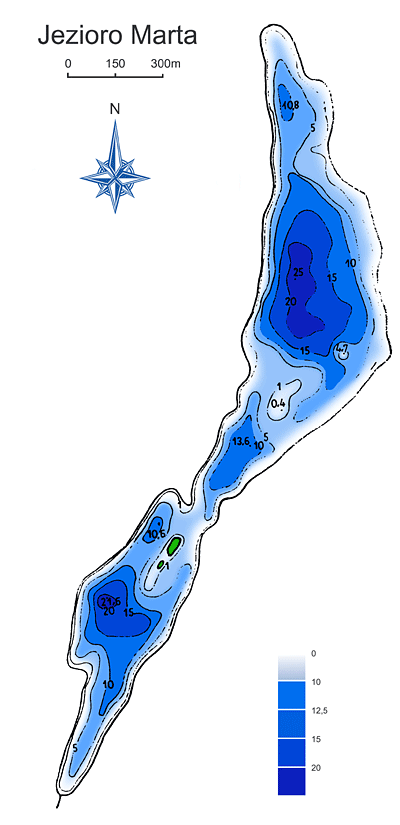Marta Lake
 Located in the northwestern part of the Park, also known as Martwica, Martew, Martynberg, Stara Marta. Elongated horizontally, it has the area of 73,69 ha and maximum depth of 25m, which makes it one of the deeper lakes of this region. The bottom of this lake is uniquely shaped with for deep spots divided by shallow patches less than 1m deep. The shallow patches are decorated with colourful underwater meadows overgrown with stonewart. The lake is a typical mesotrophic stonewart lake. The clear water has a translucency of 6m. Marta is a so-called dimictic lake, which means that the waters of its deep spots are only stirred by the wind in the spring and autumn. In summertime the thermal layering of the water is being measured. The deepest water layers here (below 7-8m) reach only 5ºC even in the warmest months of the year. However, because of a low fertility of its water, oxygen is only lacking in the deepest places pf this lake. The water level varies by around 20cm on an annual scale. Aside from one little brook in the northwest, the lake is probably being supplied by underground waters. The geological makeup of this area causes the danger of polluting the lakes waters by the waste accumulated in underground waters from the village Martew nearby.
Located in the northwestern part of the Park, also known as Martwica, Martew, Martynberg, Stara Marta. Elongated horizontally, it has the area of 73,69 ha and maximum depth of 25m, which makes it one of the deeper lakes of this region. The bottom of this lake is uniquely shaped with for deep spots divided by shallow patches less than 1m deep. The shallow patches are decorated with colourful underwater meadows overgrown with stonewart. The lake is a typical mesotrophic stonewart lake. The clear water has a translucency of 6m. Marta is a so-called dimictic lake, which means that the waters of its deep spots are only stirred by the wind in the spring and autumn. In summertime the thermal layering of the water is being measured. The deepest water layers here (below 7-8m) reach only 5ºC even in the warmest months of the year. However, because of a low fertility of its water, oxygen is only lacking in the deepest places pf this lake. The water level varies by around 20cm on an annual scale. Aside from one little brook in the northwest, the lake is probably being supplied by underground waters. The geological makeup of this area causes the danger of polluting the lakes waters by the waste accumulated in underground waters from the village Martew nearby.
Lake Marta’s fish fauna is dominated by perch and roach. In addition there is some river bream, bream, tench, pike, an eel. In the depths lives the European whitefish and lavaret, the latter however was artificially introduced to this lake by an unknown source. An ichtyological rarity here is also the silver cart, a plant eating fish of Asian origin, introduced to this area before it became the Drawa National Park.
The coastal plant life is relatively scarce here, and the rushes are dominated by twig rush, which indicates a large amount of calcium carbonate in the lake bottom. The emerald colour is characteristic for waters rich in calcium. The botanists have found here 7 different species of wart-rush, including the very rare Chara jubata. The deepest vegetation (even over a dozen metres deep) are similar to wart-rush spring-rush (Nitella flexilis).
There is a small island in the southern part of this lake. The northern and the southern bank of Marta are botanically very interesting. In the north, there is a complex of alder marshes, a small brook, and in the northeast – some meadows rich in orchids. The southern edge is a narrow but quaint bay overgrown with water vegetation and surrounded by swampy alder marshes.
The lake has been mentioned as early, as in the 16th century border documents, under the name of “Stara Martwica”.
A red hiking trail runs through the eastern bank from Pustelnia to Tuczno, by Martiwica it branches out into a blue trail to Krępa.
















